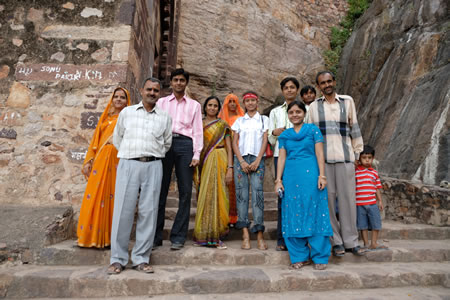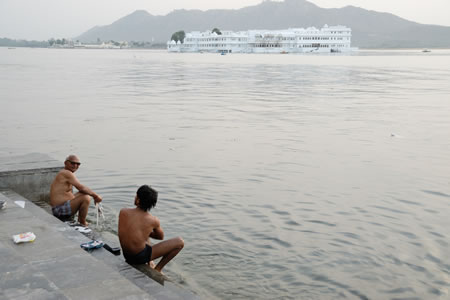English | Dutch |
|
| India: Flashback | |
Train from Delhi to Bareilly (India), December 6th 2007 |
|
After almost four months of travelling in India, it’s time to write down our impressions of our first visit to India. We travelled the four months in the north western part of India, mainly in Ladakh, Delhi, Rajasthan and Gujarat. The impression that India made on us can be described best with two words: mixed feelings. Let’s start with the positive impressions. One can not deny that India is a beautiful and many-sided country. India is the country of the fabulous Himalayas, the rich cultures, colourful festivals, beautiful wildlife reserves and old traditions. The India of today is in many facets the same India as centuries ago. Even in the huge Indian cities you still find cows on the street, people who earn their money as ear cleaner and colourful holy men that seem to be walked away from a movie scene. In many respects, India is a beautiful open air museum in where you are amazed every day several times about the things that you see. Daily life often takes place in decors that would perfectly suit in one of Steven Spielberg’s blockbusters. India is a pleasure for every sense. Besides that, India is a very pleasant country to travel in. The train systems is efficient and extensive and even the bus system is ok. Wherever you want to go in India, you can probably reach is by cheap public transport. Another positive thing about India is that many people speak English. It is great to travel in a country where you can make yourself heard and in where it is easy to communicate with the locals. So, India has all ingredients to be a top travel destination for the demanding traveller. And indeed, many people visit India these days. When you walk through Leh during the trekking season, more than 50% of the people are tourists. Also the centre of touristy cities in Rajasthan seems to be transformed to places where the tourists outnumber the locals. |
|
 |
|
Friendly Indian family at the fort of Ranthambhore NP |
|
The huge amount of tourists in some places (especially Delhi and Rajasthan of the places that we visited) is also India’s main drawback. Some areas see so many tourists that most authenticity has gone. What’s even worse is the way how tourists are treated by people who earn their money in the tourist industry. While you would expect that friendliness and service would have the highest priority, it is just not the case. Tourists are treated as cash cows that need to be milked as soon as possible. All energy is put in the milking activity which results in poor service. Cold food, dirty tables and cutlery, grubby rooms, blunt service, incorrect bills (always to your disadvantage) and suicidal auto rickshaw rides are not an exception. One does not think about the long term. It is all about the short term money. Another drawback of travelling in India, for us as westerners, is the sometimes very confronting social-cultural traditions. One of the most visible traditions is that people do not care about the environment in where they live. Everything is thrown on the street, making cities, towns and villages garbage dumps. Many people state that it has everything to do with poverty, but that’s nonsense. Even the high educated and rich people throw massively their garbage out of the train, bus or car. But poverty is one of the other social-cultural confronting aspects in India. Poverty is really extreme in India. We travelled through many countries in the past (including poor countries in Africa), but the quality of life of huge groups of Indian citizens seem to be more hopeless to us in many facets. What makes it even more confronting, is that there is lack of compassion for these people from the ‘richer’ Indians. In the hierarchical Indian society (based on the Caste system) there is little or no respect for people from lower classes. This is visible every day when you visit for example a restaurant or coffee house and where you can see how ‘richer’ people treat the servants. It is really rude, and several times we had the tendency to apologise for the behaviour of those people. The behaviour of these people is maybe a result of the Caste system (system in where people are classified in different classes), which is a major aspect of Hinduism. Hindu’s believe in reincarnation and that the class in where you are reborn depends on the thoughts and deeds in your present life. If you end your present life with a positive karma, you will be reborn in a higher class. Is your karma negative, you will be reborn in a lower class, which means that you can also be reborn as an animal. So, they believe that your quality of life depends on your behaviour in previous lives. Or in other words: it is your own fault if the quality of your present life is bad. | |
 |
|
Bathing men in Udaipur with the water palace in the background |
|
| Finally, there is also the confronting aspect of the position of women and the related dowry. It is horrible to read on a daily basis in the newspaper what family tragedies take place (read also the column: Culture Shock). If you think that it only happens in India, you are wrong. We read an article in the Times of India about a suicide railway station in a suburb of London (UK) where a big Indian-Sikh community lives. Yearly, more than 70 Indian women (mostly high educated) commit suicide at this station by jumping with their children in front of a train, because they can not satisfy with the demands of her (often low educated) husband and family-in-law. For every suicide there are also plenty of women that live in the same miserable conditions but do not take the decision to end their life. All of this is the result of the tradition of arranged marriages because the parents think that they know best who the “ideal” partner is for their son or daughter. Maybe that the discriminated position of the women is also one of the reasons why it is so difficult to get really in touch with Indian women. It is rare in India that a woman is part of a conversation with strangers. That’s why the contacts that we had during our journey through India were mainly with (young) men. You won’t see a lot of women working in the service industry where there is often contact with strangers (like: servants in restaurants, receptionists in hotels, drivers of taxi’s or rickshaws, shop keepers, guides, etc). It has probably also to do with the fact that most women do not speak English. Unfortunately, many Indian families still decide to give the best education that they can afford to their son(s) at the expense of the daughters. It is a pity that it is so difficult to meet “female” India. But it is explainable: it’s all about the men in India.
For these reasons, India is for us a country with mixed feelings. It is really a beautiful country with fabulous sights. Besides that, it is a country in where time stood still in many facets, giving you the feeling to travel in an open air museum. On the other hand, India has a lot of challenges in the social-cultural field. If it makes the necessary steps, India will hopefully transform to a country with not only fabulous sights, but also with a terrific travel experience. Till that time, it is a country that gives us mixed feelings. | |